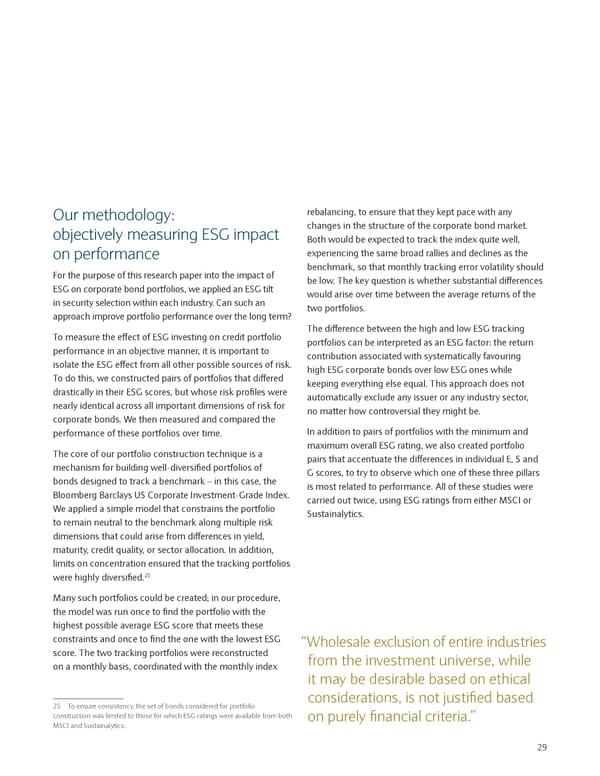Our methodology: rebalancing, to ensure that they kept pace with any objectively measuring ESG impact changes in the structure of the corporate bond market. Both would be expected to track the index quite well, on performance experiencing the same broad rallies and declines as the For the purpose of this research paper into the impact of benchmark, so that monthly tracking error volatility should ESG on corporate bond portfolios, we applied an ESG tilt be low. The key question is whether substantial differences in security selection within each industry. Can such an would arise over time between the average returns of the approach improve portfolio performance over the long term? two portfolios. To measure the effect of ESG investing on credit portfolio The difference between the high and low ESG tracking performance in an objective manner, it is important to portfolios can be interpreted as an ESG factor: the return isolate the ESG effect from all other possible sources of risk. contribution associated with systematically favouring To do this, we constructed pairs of portfolios that differed high ESG corporate bonds over low ESG ones while drastically in their ESG scores, but whose risk profiles were keeping everything else equal. This approach does not nearly identical across all important dimensions of risk for automatically exclude any issuer or any industry sector, corporate bonds. We then measured and compared the no matter how controversial they might be. performance of these portfolios over time. In addition to pairs of portfolios with the minimum and The core of our portfolio construction technique is a maximum overall ESG rating, we also created portfolio mechanism for building well-diversified portfolios of pairs that accentuate the differences in individual E, S and bonds designed to track a benchmark – in this case, the G scores, to try to observe which one of these three pillars Bloomberg Barclays US Corporate Investment-Grade Index. is most related to performance. All of these studies were We applied a simple model that constrains the portfolio carried out twice, using ESG ratings from either MSCI or to remain neutral to the benchmark along multiple risk Sustainalytics. dimensions that could arise from differences in yield, maturity, credit quality, or sector allocation. In addition, limits on concentration ensured that the tracking portfolios 25 were highly diversified. Many such portfolios could be created; in our procedure, the model was run once to find the portfolio with the highest possible average ESG score that meets these constraints and once to find the one with the lowest ESG “Wholesale exclusion of entire industries score. The two tracking portfolios were reconstructed from the investment universe, while on a monthly basis, coordinated with the monthly index it may be desirable based on ethical 25 To ensure consistency, the set of bonds considered for portfolio considerations, is not justified based construction was limited to those for which ESG ratings were available from both on purely financial criteria.” MSCI and Sustainalytics. 29
 Sustainable Investing and Bond Returns Page 32 Page 34
Sustainable Investing and Bond Returns Page 32 Page 34